Note: If you like this post, I’ve expanded the material quite a bit in my chapbook Avian Neighbors: Being a Good Steward to Backyard Birds.
Well, winter arrived right on schedule here on the southwest Washington coast. Christmas night saw temperatures drop, and we ended up accumulating a few inches of snow in the time since then. This means that it’s gotten even tougher for wildlife to scrounge out food under the snow, and even though it will likely start melting today, the pickings will still be slim. This has gotten a lot of people wondering about how to feed birds, and how to keep our avian neighbors safe in the process.
Consider this an introductory guide on how to feed birds; there are many websites and even books on the topic if you want to do even more research. In the meantime, though, read on to get the basics of bird feeding.
What Birds Are Okay to Feed?
First, let’s talk about what sorts of birds you can expect at your feeders; here are some common groups:
Songbirds: these small perching birds are the most common feeder visitors and include a wide variety of species from sparrows and finches to thrushes and bluebirds, and many more!
Woodpeckers: while not as numerous as songbirds, if you have a suet feeder out it may very well attract local woodpeckers, from the tiny downy woodpecker (Dryobates pubescens) to the larger northern flicker (Colaptes auratus)–and maybe even a pileated woodpecker, the largest common woodpecker (Dryocopus pileatus) in North America!
Corvids: This group includes crows, jays, ravens, and a few other species like the Clark’s nutcracker (Nucifraga columbiana). These intelligent birds often go for larger foods like peanuts, though they can eat suet and other food as well.
Hummingbirds: these high-octane little birds need a lot of sugar to survive the cold winter. Here in the Pacific Northwest the Anna’s hummingbird (Calypte anna) will stick around all year as feeders and relatively mild weather allow.
All of these birds are generally okay to feed; they are not likely to become completely dependent on your feeders for survival (with the exception of Anna’s hummingbirds which are dependent on feeders as they have moved their range northward in recent years.) Most of the others, though, have other food options. And they’re used to having to move from place to place as food sources dry up, so if you need to bring your feeders in for any reason the birds will just go somewhere else.
However, be aware that there may be local restrictions on certain species. Florida scrub jays (Aphelocoma coerulescens), for example, are highly endangered, and it is illegal to feed them. Why? Well, the young need their diet to be about 75% insects and other terrestrial invertebrates for the first few weeks of their life. Feeding Florida scrub jays encourages them to nest earlier in the year before there are enough insects to feed the young, and so many young die of malnutrition, putting the species at greater risk of extinction.

Finally, a word about waterfowl, which includes ducks, geese, and swans: most of us at some point in our lives have gone to a pond or lake to feed bread to ducks and geese. This may seem sweet, but it’s a terrible idea. First, bread is basically empty calories for these birds, so eating too much can make them malnourished and even make their wings become so deformed they can’t fly. Feeding them things like peas and corn isn’t much better, because unlike other birds, waterfowl are much more likely to become habituated to humans and dependent on us for food, making them less likely to forage for food naturally. Adding more food to the ecosystem means higher rates of reproduction, and that leads to overpopulation which can cause outbreaks of fatal diseases, and even starvation when population outstrips the amount of available food. Finally, more waterfowl means more poop in the water, which can kill other aquatic animals and cause algae blooms that crowd out vegetation; eventually this pollution can destroy the entire ecosystem, and in extreme cases the ongoing process of eutrophication causes the pond to eventually fill in and become a meadow.
What Kind of Feeders Should I Have?
There are several factors when determining not just how to feed birds, but in what sorts of feeders. There are lots of varied and unique designs out there that appeal to different groups of birds. Here are some of the more common ones:
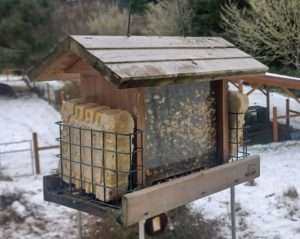 Hopper Feeders: These are the classic bird feeder with a compartment for seed-type feeds, and a roof on top. Some have suet feeders on the sides.
Hopper Feeders: These are the classic bird feeder with a compartment for seed-type feeds, and a roof on top. Some have suet feeders on the sides.
Suet Feeders: This is usually a square or rectangle made of wire grid inside which a square of suet can be placed.
Tube Feeders: These are vertical tubes with apertures at various heights that allow birds to get at the seed inside. Some are made of clear plastic, while others consist of a tube of fine-mesh wire.
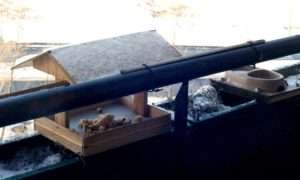 Platform Feeders: A simple feeder made of a wooden platform with a low rim around the edge that then is either hung from cords or chains at each corner, or set on a post. Any sort of loose food can be placed here, though they’re especially popular for bulkier foods like nuts, and larger birds like jays, woodpeckers, and crows.
Platform Feeders: A simple feeder made of a wooden platform with a low rim around the edge that then is either hung from cords or chains at each corner, or set on a post. Any sort of loose food can be placed here, though they’re especially popular for bulkier foods like nuts, and larger birds like jays, woodpeckers, and crows.
Hummingbird Feeders: There are several designs of hummingbird feeder out there, but they all have a compartment inside for hummingbird nectar with small holes–often shaped like flowers–for the hummingbirds to feed from.
You can even make organic bird feeders at home. A popular design that’s fun for both kids and adults is to hang up pine cones covered in peanut butter and then rolled in seeds. You can also use a needle to thread popcorn, apple slices, and other tasty treats to hang up.
Be aware that your feeders will drop some feed onto the ground; this can attract ground-feeding birds like sparrows and towhees. If you’re in a more rural area, some foods like cracked corn on the ground might even get your local turkeys or ducks to show up now and then! And yes, food on the ground may attract other animals like squirrels; I’ll talk more about that later in the article.
What Sort of Bird Food Should I Choose?
Well, that depends on what sorts of birds you want to attract! If you’re really picky about what species you want to show up you can research what their usual winter foods are, and then offer something similar to what they would find in nature. However, most people are happy to feed whoever’s in the area.
 Most songbirds eat seeds of some sort; finches are partial to thistle seeds (also known as nyjer seeds), while black oil sunflower seeds are popular with just about everyone! Hulled sunflower seeds are more expensive but they are accessible to smaller birds that may not be able to break into sunflower seed hulls. Cracked corn is also a good general-use choice.
Most songbirds eat seeds of some sort; finches are partial to thistle seeds (also known as nyjer seeds), while black oil sunflower seeds are popular with just about everyone! Hulled sunflower seeds are more expensive but they are accessible to smaller birds that may not be able to break into sunflower seed hulls. Cracked corn is also a good general-use choice.
During cold weather suet is another great offering as the fat gives birds the energy they need to stay warm. it also may attract jays, woodpeckers, and other birds that may not be as interested in small seeds. Another high-calorie food, peanuts, can not only attract these larger birds, but you may watch them fly off and cache some for the future! Safflower nuts are also a good choice for birds with heavier bills that can crack them open–and they also don’t appeal to squirrels.
If you really want to spoil your local birds, put a few mealworms out in a platform feeder. You can get live mealworms at any pet store, and keep them in the fridge until they’re ready to use. You don’t want to put the entire package out at once; a dozen or so is plenty. Once the birds discover them, though, they’ll go fast! Be aware that dried mealworms are out there, but the birds will be less likely to eat them. If you really want to get serious about offering mealworms on a regular basis, they’re super easy to raise at home!
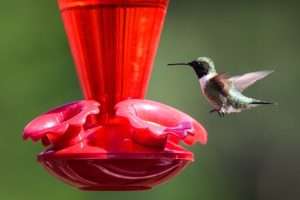 Hummingbirds are a special case, as they only eat nectar from feeders (though they do also consume a lot of small insects during warmer months!) DO NOT get nectar mix that has red dye in it; the dye is VERY bad for them. Instead, mix white refined sugar (not raw sugar, not brown sugar, not honey, etc.) in boiling water at a 1:4 ratio; stir until the sugar has completely dissolved, and then let cool before putting in the feeder. If the hummingbirds are not regularly emptying the feeder, you should change the nectar weekly, or 2-3 times a week if the temperatures are warmer (or daily if it’s really hot, like above 90 degrees.) Also, bring your feeder in at night if temperatures are going to be below freezing. Some people have multiple feeders that they switch out every few hours when daytime temperatures are below freezing so that the hummingbirds always have fresh food.
Hummingbirds are a special case, as they only eat nectar from feeders (though they do also consume a lot of small insects during warmer months!) DO NOT get nectar mix that has red dye in it; the dye is VERY bad for them. Instead, mix white refined sugar (not raw sugar, not brown sugar, not honey, etc.) in boiling water at a 1:4 ratio; stir until the sugar has completely dissolved, and then let cool before putting in the feeder. If the hummingbirds are not regularly emptying the feeder, you should change the nectar weekly, or 2-3 times a week if the temperatures are warmer (or daily if it’s really hot, like above 90 degrees.) Also, bring your feeder in at night if temperatures are going to be below freezing. Some people have multiple feeders that they switch out every few hours when daytime temperatures are below freezing so that the hummingbirds always have fresh food.
It can be tough to decide what to put out there! If funds are limited, you’ll get the most bang for your buck with a mix of sunflower seeds and cracked corn. If it’s space that’s at a premium, consider a feeder that allows for multiple types of food–for example a hopper feeder that has a compartment for seeds, but also suet cages on the sides. Also, hummingbird feeders take up very little space, so you may be able to add one without making things too cluttered.
It may be tempting to just get the big bag of mixed feed at the store. Be aware that many of these are largely composed of millet seeds and other fillers that will often be ignored by wild birds. If you want to try one bag to see what foods your local birds are most interested in that’s fine, but then buy just those foods individually and make your own mix without filler going forward.
If you’re going to store large quantities of bird food, especially if you mix your own, a metal trash can with a good, tight-fitting lid makes a great container. It’s rodent-proof, easy to clean, and helps keep the food from being spoiled by heat or insects.
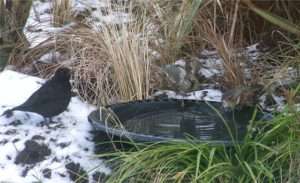 Finally, food is great, but you also want to make sure your local birds have a source of fresh water! You may have to break through ice on a cold morning, and you need to change the water every day. But it will help keep the birds healthy and happy, and give them even more reasons to come back to your yard. While a bird bath or other still water works just fine, some people find that small electric fountains keep the water fresher, and the sound will help attract more birds, including those that may not be interested in the feeders.
Finally, food is great, but you also want to make sure your local birds have a source of fresh water! You may have to break through ice on a cold morning, and you need to change the water every day. But it will help keep the birds healthy and happy, and give them even more reasons to come back to your yard. While a bird bath or other still water works just fine, some people find that small electric fountains keep the water fresher, and the sound will help attract more birds, including those that may not be interested in the feeders.
How to Feed Birds Safely
Do you remember last winter and spring when wildlife officials in the Pacific Northwest told us to bring our feeders in for a few weeks? That was due to an outbreak of Salmonella infections, primarily among pine siskins (Spinus pinus). All birds carry Salmonella naturally; however, pine siskins seem to be especially prone to salmonellosis. Moreover, that species had experienced an irruption, which is when large numbers of a particular species move out of their normal range at once, usually in search of food. In this case, boreal forests in Canada and the northern U.S. didn’t provide enough conifer seeds, and so the siskins had to go on the move for food. (More intense wildfire seasons and climate change also haven’t helped the food situation.)
Now, here’s one of the big downsides of bird feeders: they cause birds to congregate in unnaturally large numbers, often several times a day, in the same spot. This increases the chance for disease transmission. Add in a whole bunch of pine siskins, some of which had salmonellosis, and the result was a large outbreak of Salmonella infections, not just among siskins but other species to a lesser degree. The feeders were the main vector, and bringing them in to help disperse the birds more widely was considered the best option even though it removed many sources of food.
How can we help avoid spreading disease through our feeders? By keeping them clean! Once a week bring your feeders inside, and clean them well with soap and hot water, or a diluted bleach solution. At night you can also empty out any uneaten food, spray the feeders down with a 50-50 vinegar-water solution, and then refill the food in the morning.
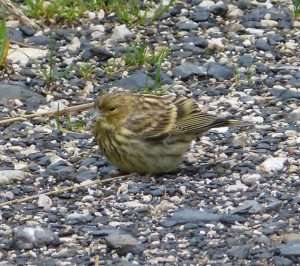
Should you notice a sick bird on your feeders, it’s time to bring them in for at least a week. Sick birds often have ragged feathers, crusty eyes and nostrils, and may be lethargic-they just look unhappy! It may seem cruel to take away their food, but if they’re carrying something contagious they could easily pass it to others (just imagine how quickly a cold or flu passes around an office building!)
You can also help reduce disease transmission by having multiple feeders, each one with a different type of food. This means that each feeder will attract only the types of bird that like the food it carries. However, if you only have room for one or two feeders, just make extra sure you keep them very clean since they’ll get more visitors and more cross-contamination.
Another important way to keep your local birds safe is to not let them get habituated to you and other humans. Just because these birds feel confident enough to come to your feeders does not mean you should treat them like pets. Pay attention to when birds are least likely to show up at your feeders, and use those times to refill them. And never, ever, ever do anything to encourage the birds to lose their fear of you, like trying to get them to eat out of your hand! It’s irresponsible, and while it may seem cute to us, it is often bad for the birds long-term as it can cause them to be less cautious around humans and make it more likely they will be injured or killed at our hands.
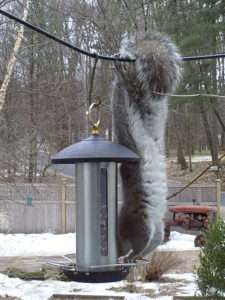 While your goal may be to feed the birds, you’re likely going to end up feeding other wildlife, too. Squirrels are the most notorious feeder “thieves”, and many people have gone to great lengths trying to thwart these clever acrobats. There are squirrel-proof bird feeders out there (like those at this link), though no feeder is 100% effective. The above link also has some other great tips for deterring squirrels like creating barriers that keep them away from the food, or mixing cayenne powder in the food (birds can’t taste it, but the squirrels sure can!)
While your goal may be to feed the birds, you’re likely going to end up feeding other wildlife, too. Squirrels are the most notorious feeder “thieves”, and many people have gone to great lengths trying to thwart these clever acrobats. There are squirrel-proof bird feeders out there (like those at this link), though no feeder is 100% effective. The above link also has some other great tips for deterring squirrels like creating barriers that keep them away from the food, or mixing cayenne powder in the food (birds can’t taste it, but the squirrels sure can!)
Even if you can keep squirrels and other climbing mammals off your feeders, you still have to deal with the mess underneath the feeder that can attract rats, mice, and other critters. A platform underneath your feeder can help catch a lot of the food scattered by feeding birds, and cleaning it daily keeps the food mess to a minimum. If your birds are really messy you may need to string up a tarp underneath the feeders! Trapping is sometimes the best option for persistent non-native rodents like house mice or brown rats; if you can figure out where they’re nesting nearby, putting traps near their burrows can help knock the population back some (just make sure you always handle traps and bait wearing gloves so that they don’t smell like humans!) If the trap is close to the feeders or otherwise exposed, you may need to put a cover over it with a couple of small openings so rodents can get in, but the birds stay out.
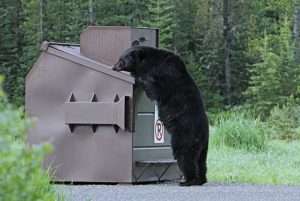
Finally, some of us out in rural areas have to deal with much larger visitors: black bears (Ursus Americanus)! They can be just as good at climbing as squirrels, and they’re big enough to carry entire feeders away. In this case, your best bet is to get the feeders high enough off the ground so that they can’t reach them. My feeders are on hooks attached to the outside of my second-story window, but I’ve also seen people rig pulley systems with ropes over tall tree branches. The feeders hang on the ropes high enough that the bears can’t reach them from the ground, but far enough below the branch that they can’t get them from there, either. It’s also extra important that you store any extra feed indoors, as bears can easily get into trash cans and other containers.
One more thing: bird feeders can sometimes act as a great hunting spot for predators. My advice is to not worry if it’s a native predator like a Cooper’s hawk (Accipiter cooperii) or other wild animal. After all, they need to eat, too! And they’d be preying on these birds either way. It can be disturbing for some people to see the cycle of life and death up close and personal, so you may need to decide whether this is something that you’re okay with before you put up feeders, as harassing wild birds is definitely unethical, and it is against federal law to trap or kill raptors and most other wild birds in the United States.

However, if the culprit is a domestic cat (Felis catus), this is far outside the bounds of native nature. Cats are an introduced species, and in fact domestic cats are not native anywhere as they are derived from wild species but are not wild themselves, and they would not be here if we had not domesticated them and then taken them with us around the world. Cats also are the single biggest human-derived killer of birds, killing almost two and a half BILLION wild birds every year in the United States alone.
If you have cats, it’s best for both their safety and that of wildlife to keep them strictly indoors, and to only let them outside on a leash or in a catio. If it’s your neighbor’s cat that’s the problem, ask your neighbor to keep their free-roaming cat off your property (yes, you have the right to do so!) If the cat persists, or if you don’t know who the cat’s owner is, you can contact your local animal control to see about live-trapping. If the cat’s owner is known the cat will be returned with a warning; otherwise, the cat can be placed for adoption.
